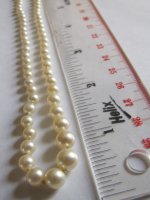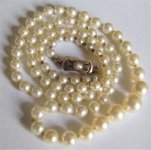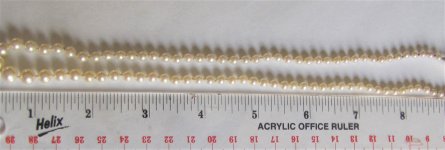Hello group, Have had this old necklace for quite some time and thought they were not real, but the other day decided to check them out again and now believe they are real because I can see imperfections with a loupe. Another discovery was that the gold clasp tested as 14K with acid. So, am wondering what type of pearls they are and if there is any possibility they are Mikimoto because of the clasp? Btw, I am learning alot from this very helpful and informed group and want to say THANK YOU SO MUCH!
Attachments
-
 pearl necklace 14k gold clasp rectangle with pearl whole on paper good.JPG1.3 MB · Views: 255
pearl necklace 14k gold clasp rectangle with pearl whole on paper good.JPG1.3 MB · Views: 255 -
 pearl necklace 14k gold clasp rectangle with pearl close.JPG1.4 MB · Views: 271
pearl necklace 14k gold clasp rectangle with pearl close.JPG1.4 MB · Views: 271 -
 pearl necklace 14k gold clasp rectangle with pearl with ruler close.JPG1 MB · Views: 259
pearl necklace 14k gold clasp rectangle with pearl with ruler close.JPG1 MB · Views: 259 -
 pearl necklace 14k gold clasp rectangle with pearl on paper good 2.JPG1.1 MB · Views: 245
pearl necklace 14k gold clasp rectangle with pearl on paper good 2.JPG1.1 MB · Views: 245 -
 pearl necklace 14k gold clasp rectangle with pearl withh ruler.JPG562.8 KB · Views: 264
pearl necklace 14k gold clasp rectangle with pearl withh ruler.JPG562.8 KB · Views: 264


